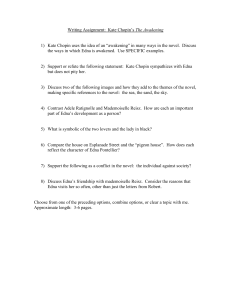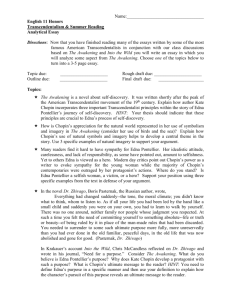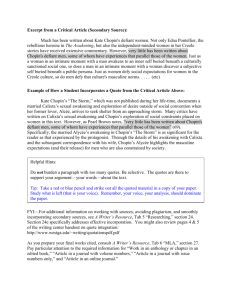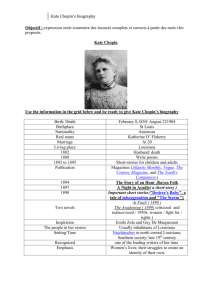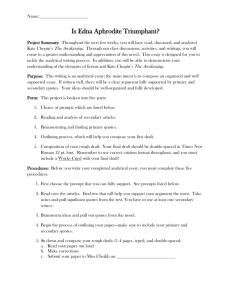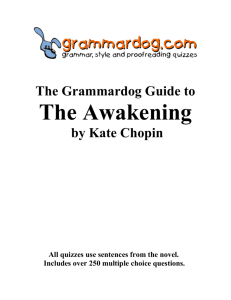THE AWAKENING
advertisement
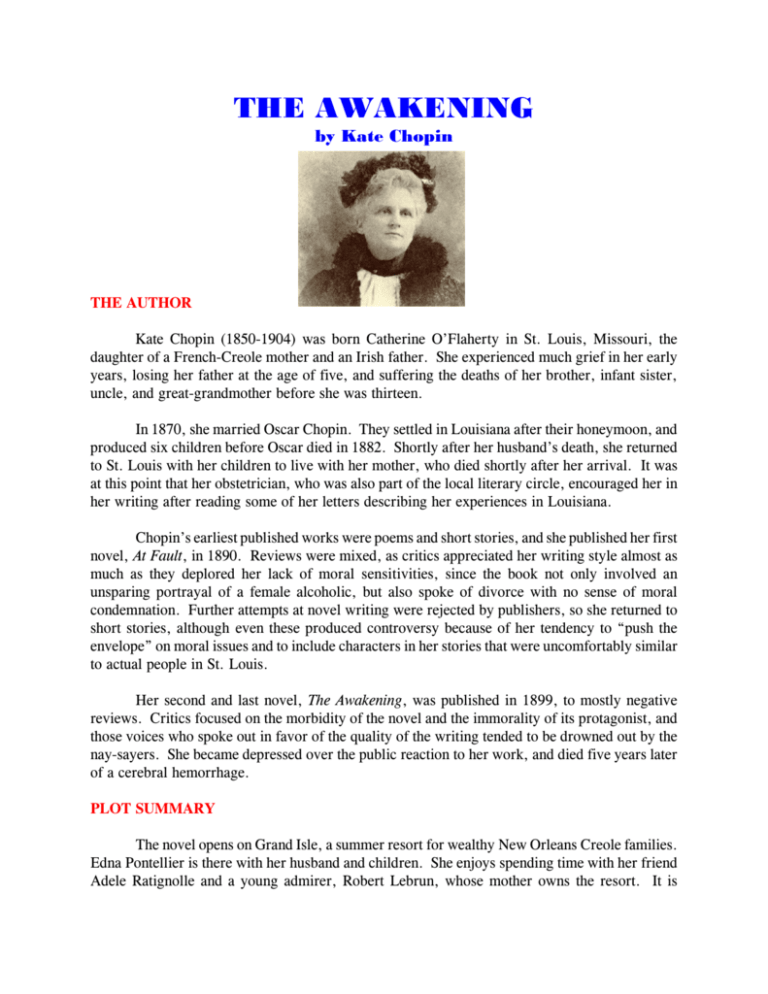
THE AWAKENING by Kate Chopin THE AUTHOR Kate Chopin (1850-1904) was born Catherine O’Flaherty in St. Louis, Missouri, the daughter of a French-Creole mother and an Irish father. She experienced much grief in her early years, losing her father at the age of five, and suffering the deaths of her brother, infant sister, uncle, and great-grandmother before she was thirteen. In 1870, she married Oscar Chopin. They settled in Louisiana after their honeymoon, and produced six children before Oscar died in 1882. Shortly after her husband’s death, she returned to St. Louis with her children to live with her mother, who died shortly after her arrival. It was at this point that her obstetrician, who was also part of the local literary circle, encouraged her in her writing after reading some of her letters describing her experiences in Louisiana. Chopin’s earliest published works were poems and short stories, and she published her first novel, At Fault, in 1890. Reviews were mixed, as critics appreciated her writing style almost as much as they deplored her lack of moral sensitivities, since the book not only involved an unsparing portrayal of a female alcoholic, but also spoke of divorce with no sense of moral condemnation. Further attempts at novel writing were rejected by publishers, so she returned to short stories, although even these produced controversy because of her tendency to “push the envelope” on moral issues and to include characters in her stories that were uncomfortably similar to actual people in St. Louis. Her second and last novel, The Awakening, was published in 1899, to mostly negative reviews. Critics focused on the morbidity of the novel and the immorality of its protagonist, and those voices who spoke out in favor of the quality of the writing tended to be drowned out by the nay-sayers. She became depressed over the public reaction to her work, and died five years later of a cerebral hemorrhage. PLOT SUMMARY The novel opens on Grand Isle, a summer resort for wealthy New Orleans Creole families. Edna Pontellier is there with her husband and children. She enjoys spending time with her friend Adele Ratignolle and a young admirer, Robert Lebrun, whose mother owns the resort. It is quickly obvious that, though Edna loves her family, she doesn’t enjoy being a wife and mother, nor does she really fit in with the other women on the island. Robert has developed a habit of attaching himself to a different woman at the resort each summer, so no one takes his relationship with married women seriously, including himself. As the days pass on the island, Edna’s gradual transformation is indicated, not only through her increasingly serious relationship with Robert, but also through the fact that she learns to swim, and is entranced by the piano playing of Mademoiselle Reisz, a social outcast who cares nothing for the constraints of the surrounding world. Her discomfort in socially accepted environments like parties and church also contribute to her alienation from the people around her, and she grows increasingly rebellious against the desires of her husband. She then hears that Robert is planning to leave for Mexico to make his fortune - a departure of which he has told her nothing. He finally comes to say goodbye, but they avoid the topic of their mutual attraction. At the end of the summer, the Pontelliers return to their lavish home in New Orleans, but Edna finds it confining, and hates all the social and domestic responsibilities with which she is burdened. When she begins to neglect those duties, her husband becomes angry with her. As Edna increasingly occupies her time with art and long walks through the city, she grows more distant from friends like Adele and becomes closer to Mademoiselle Reisz, not only because of her musical ability, but also because she has been receiving letters from Robert in Mexico which speak of little else than Edna, though he fears to admit his love for her because she is not “free.” Meanwhile, Leonce contacts his friend Dr. Mandelet because he is worried about the changes he sees in his wife. The doctor advises Leonce to let his wife do whatever she wants, but is secretly concerned that she is in love with another man. Leonce plans to go away on a business trip, and send the children to visit their grandparents. Meanwhile, Edna’s father visits, and she waits on him hand and foot, but he becomes angry when she refuses to attend her sister’s wedding. After her father, husband, and children leave, Edna takes advantage of her new-found freedom to do whatever she pleases, and eventually makes plans to leave her home and move into a little house around the corner that will be all her own. Leonce opposes the idea because he is afraid people might think he is having financial problems, but he gets around the issue by ordering a massive remodeling of the mansion. Edna also becomes involved with Alcee Arobin, the local playboy, with whom she has a brief affair, though she clearly does not love him. While visiting Mademoiselle Reisz, she discovers that Robert is soon to return home. After Robert comes back to New Orleans, he is reluctant to visit Edna because he is unsure of where he stands and fearful of her position as a married woman. She continues to see Alcee on a casual basis. Robert and Edna meet one day by accident in a garden, and he returns with her to her little cottage, where they embrace and he confesses his love for her and his desire to marry her if she were free of her husband. She insists that she is a free woman who can give herself to whomever she desires. They are interrupted by a messenger who summons Edna to assist Adele, who is ready to give birth. She asks Robert to remain until she returns, but when she gets back, she finds that he has gone, leaving a note explaining that, because of his love for her, he can never see her again. The next day, she goes out to Grand Isle, discards her clothing, and swims naked out into the ocean until exhaustion overcomes her and she drowns. MAJOR CHARACTERS • Edna Pontellier - The protagonist of the story, Edna is a wife and mother in her late twenties who, as the novel progresses, becomes increasingly discontent with her lot in life as she pursues her love for Robert and her desire for artistic expression. • Leonce Pontellier - Edna’s husband, he treats her as another one of his possessions, and expects from her complete submission and devotion to the needs of himself and their two children. • The Colonel - Edna’s father, a Civil War veteran and strict traditionalist. • Robert Lebrun - A young man with a history of being devoted to a different woman each summer at the Grand Isle resort his mother owns, he is the man with whom Edna falls in love. He ultimately chooses to break off their relationship because he cannot have her as his wife. • Mrs. Lebrun - Robert’s mother, the owner of the Grand Isle resort. • Adele Ratignolle - Edna’s best friend, she is the ideal of Victorian womanhood, devoting herself entirely to the welfare of her husband and children. As the story progresses, she and Edna become increasingly distant from one another. • Mademoiselle Reisz - A spinster musician that Edna meets on the island but increasingly begins to seek out after her return to New Orleans. She warns Edna that the artist must be strong in order to defy social conventions. • Alcee Arobin - A New Orleans playboy with whom Edna has a brief affair. • Doctor Mandelet - The Pontelliers’ family physician, he advises Leonce to let Edna do what she wants, though he suspects that she is in love with another man. He offers Edna his help and listening ear, but his offer comes too late. NOTABLE QUOTATIONS “The voice of the sea is seductive, never ceasing, whispering, clamoring, murmuring, inviting the soul to wander for a spell in abysses of solitude; to lose itself in mazes of inward contemplation. The voice of the sea speaks to the soul. The touch of the sea is sensuous, enfolding the body in its soft, close embrace.” (p.13) “Mrs. Pontellier was not a woman given to confidences, a characteristic hitherto contrary to her nature. Even as a child, she had lived her own small life all within herself. At a very early period she had apprehended instinctively the dual life - that outward existence which conforms, the inward life which questions.” (p.13) “But that night she was like the little tottering, stumbling, clutching child, who all of a sudden realizes its powers, and walks for the first time alone, boldly and with over-confidence. She could have shouted for joy. She did shout for joy, as with a sweeping stroke or two she lifted her body to the surface of the water.” (p.27) “Mr. Pontellier was very fond of walking about his house examining its various appointments and details, to see that nothing was amiss. He greatly valued his possessions, chiefly because they were his, and derived genuine pleasure from contemplating a painting, a statuette, a rare lace curtain - no matter what - after he had bought it and placed it among his household gods.” (p.50) “There were days when she was happy without knowing why. She was happy to be alive and breathing, when her whole being seemed to be one with the sunlight, the color, the odors, the luxuriant warmth of some perfect Southern day. She liked then to wander alone int o strange and unfamiliar places. She discovered many a sunny, sleepy corner, fashioned to dream in. And she found it good to dream and to be alone and unmolested.” (p.58) “Neither was it quite clear to Edna herself; but it unfolded itself as she sat for a while in silence. Instinct had prompted her to put away her husband’s bounty in casting off her allegiance. She did not know how it would be when he returned. There would have to be an understanding, an explanation. Conditions would some way adjust themselves, she felt; but whatever came, she had resolved never again to belong to another than herself.” (p.80) “How strange and awful it seemed to stand naked under the sky! how delicious! She felt like some new-born creature, opening its eyes in a familiar world that it had never known.” (p.115) “She thought of Leonce and the children. They were a part of her life. But they need not have thought that they could possess her, body and soul.” (p.116) ESSAY QUESTIONS Discuss the following in a five-paragraph essay: 1. Both Kate Chopin’s The Awakening and Leo Tolstoy’s Anna Karenina are stories of marital unfaithfulness, yet they treat their subject in vastly different ways. Discuss the different views of human nature, morality, responsibility to society, and personal fulfillment presented by Chopin and Tolstoy in their respective novels. 2. Discuss the appropriateness of the title of Kate Chopin’s The Awakening. Is what happens to the protagonist rightly described by the term “awakening,” or would some other term be more appropriate? 3. According to biographers, Kate Chopin was fascinated by Charles Darwin’s theory of evolution. How does this fascination affect her most famous novel, The Awakening? In what ways does the novel communicate a Darwinian view of human nature? 4. In Kate Chopin’s The Awakening, Edna Pontellier continually struggles to “find herself.” Her quest has much to do with the settings in which the author places her. How do the three major settings of the book - Grand Isle, the Pontellier mansion, and the “pigeon house” - influence Edna’s sense of herself? Does she ever truly find herself? Why or why not? 5. Assess from a biblical standpoint the concept of womanhood presented in Kate Chopin’s The Awakening. 6. In Kate Chopin’s The Awakening, does Edna Pontellier ever truly find freedom? If so, of what does that freedom consist? If not, what constraints prevent her from finding it? 7. Based on what you know of the cultural and intellectual environment in the United States at the end of the nineteenth century, discuss ways in which Kate Chopin’s The Awakening both reflects and extends the ideas that were considered socially controversial at the time. 8. Discuss the following: “Despite the fact that it contains no acts of sex or violence and a minimum of bad language, Kate Chopin’s The Awakening is a fundamentally immoral book.” 9. Discuss the implications for women’s rights of the narrative contained in Kate Chopin’s The Awakening. Based on the book, to what extent may one conclude that modern feminism is the enemy of Christianity? 10. “Choked by the cloistering, moralistic garb of the Victorian era, yet willing to give up everything - even her own life - for the freedom of unencumbered individuality, Edna Pontellier epitomized the consummate New Woman of the late nineteenth century.” What does Kate Chopin’s The Awakening indicate about the consequences of pursuing “unencumbered individuality”? Is “unencumbered individuality” a desirable goal for one to pursue? 11. Aristotle defined tragedy as a story in which a great person comes to a bad end because of a flaw in his character. Based on this definition, is Kate Chopin’s The Awakening a tragedy? Why or why not? 12. Kate Chopin’s The Awakening was scorned by critics when it first appeared in 1899. When it was republished in 1969, however, it met with widespread acclaim, and has since become one of the most frequently taught novels in American high schools. How did the social conditions in 1899 and 1969, respectively, contribute to the significantly different ways in which people responded to Chopin’s novel? 13. In Kate Chopin’s The Awakening, Edna Pontellier rejects her roles as wife and mother because she abhors the concept of self-denial, choosing instead the path of self-fulfillment. Assess her choice from the standpoint of Scripture. 14. Art plays an important role in Kate Chopin’s The Awakening, both through the music of Mademoiselle Reisz and the painting of Edna Pontellier. What is the value of art, according to the novel? How do this understanding of the purpose of art and the style of writing adopted by Chopin in the novel relate to the Impressionism that was so popular in the world of painting at the end of the nineteenth century? 15. Chopin biographer Per Seyersted said in reference to The Awakening, “The attitude she lets Mrs. Pontellier illustrate comes close to that of existentialism. She seems to say that Edna has a real existence only when she gives her own laws, when she through conscious choice becomes her own creation with an autonomous self.” Do you agree? In what senses may Kate Chopin’s The Awakening be viewed as a literary forerunner of existentialism? 16. In Matthew 16:24-26, Jesus says to His disciples, “If anyone would come after me, he must deny himself and take up his cross and follow me. For whoever wants to save his life will lose it, but whoever loses his life for me will find it. What good will it be for a man if he gains the whole world, yet forfeits his soul? Or what can a man give in exchange for his soul?” How does Kate Chopin’s The Awakening illustrate the truth of Jesus’ words? At the end of the novel, does Edna Pontellier gain her soul or lose it? Why? 17. Discuss the significance of the symbol of birds in Kate Chopin’s The Awakening. 18. In Kate Chopin’s The Awakening, Edna Pontellier’s two closest female friends, Adele Ratignolle and Mademoiselle Reisz, are clearly opposites, picturing very different attitudes toward the functions of life and art. What differences to they portray, and how do they influence the trajectory of Edna’s awakening? 19. In Kate Chopin’s The Awakening, Edna Pontellier finds church oppressive. What does her attitude indicate about the author’s view of the role of religion in society? How has this same attitude exerted an influence on the society in which we live? 20. Discuss the symbolic use of clothing in Kate Chopin’s The Awakening. From the beginning of the book to its end, how do changes in clothing reflect the progress of Edna Pontellier’s awakening? What do these changes imply about the relationship between the individual and society, and the nature of freedom? 21. Compare and contrast the treatment of the sexual double standard in Edith Wharton’s The Age of Innocence and Kate Chopin’s The Awakening. Both novelists create settings in oldmoney upper-class society, though one is in the North and the other the South. Consider especially the characters of Ellen Olenska and Edna Pontellier in developing your answer, and note both the messages of the authors and the behavior and choices of the characters. 22. Edith Wharton’s Ethan Frome and Kate Chopin’s The Awakening are both short novels centering on illicit loves. Though the two were written only a little more than a decade apart, one could hardly imagine two perspectives more different. Discuss the similarities and, mostly, the differences between the two stories, considering the authors’ perspectives, the personalities of the characters, and thematic elements. 23. Compare and contrast the moral perspectives of Gustave Flaubert’s Madame Bovary and Kate Chopin’s The Awakening. Do the two authors have the same perspective on the adulterous behavior of their protagonists? Do they approve of the actions of Emma Bovary and Edna Pontellier or do they consider them immoral? How do you know? Use supporting details from the two novels to support your conclusions. 24. Compare and contrast the social criticism found in Gustave Flaubert’s Madame Bovary and Kate Chopin’s The Awakening. What aspects of society do the two authors despise? Give special consideration to the views of women displayed by the two novelists. 25. Compare and contrast the inner lives of the protagonists of Gustave Flaubert’s Madame Bovary and Kate Chopin’s The Awakening. What are the attitudes toward life that drive them to adultery? Do the two women have good reason to be dissatisfied with their marriages? Are their expectations about what their lives should look like realistic? Why or why not? 26. Compare and contrast the attitudes of Emma Bovary and Edna Pontellier toward their children in Gustave Flaubert’s Madame Bovary and Kate Chopin’s The Awakening. How do others suffer for the sins of the protagonists? Do the authors acknowledge this suffering or ignore it? Why do you think so? 27. Compare and contrast the suicides of the protagonists in Gustave Flaubert’s Madame Bovary and Kate Chopin’s The Awakening. How do the attitudes with which the two women approach death differ? How do these differences illumine the attitudes of the authors toward what the two women have done? Be specific. 28. Compare and contrast Leon Dupuis and Rodolphe Boulanger in Gustave Flaubert’s Madame Bovary with Robert Lebrun and Alcee Arobin in Kate Chopin’s The Awakening. Do the pairs of lovers with whom the protagonists become involved play the same roles in the two stories? How do their differences help to bring out the themes of the respective novels? Be sure to support your discussion with specifics from the two stories. 29. Consider the treatment of adulterous women found in Gustave Flaubert’s Madame Bovary, Kate Chopin’s The Awakening, and Leo Tolstoy’s Anna Karenina. Which differs most from the others? How would you explain these differences? 30. Both Gustave Flaubert’s Madame Bovary and Kate Chopin’s The Awakening were condemned as immoral books when they were first published. Do you agree with this assessment? Why or why not? Remember that the moral value of a story deals not only with what it depicts, but also with the perspective it takes on those characters and events. Support your conclusion from Scripture as well as from the novels themselves. 31. Both Thomas Hardy’s Tess of the D’Urbervilles and Kate Chopin’s The Awakening decry the sexual double standard, yet they are very different novels. To what extent can the different ways they approach their subject be explained by the fact that one author is reflecting on the British experience, while the other is American? How do the differences in the two cultures account for the different tones and styles of the novels? 32. Both Thomas Hardy’s Tess of the D’Urbervilles and Kate Chopin’s The Awakening decry the sexual double standard, yet they are very different novels. Which of the two female protagonists creates greater sympathy for the injustice of the double standard in your mind as you read? What accounts for the greater effectiveness of one story over the other? 33. Compare and contrast Thomas Hardy’s Tess of the D’Urbervilles and Kate Chopin’s The Awakening with regard to their views of the relationship between love and sex. In the light of this analysis, which one would you consider the more “modern” novel? Why? 34. Both Thomas Hardy’s Tess of the D’Urbervilles and Kate Chopin’s The Awakening scandalized the public when they appeared. Chopin’s novel practically ended the author’s writing career as soon as it began, while the public reaction to Tess of the D’Urbervilles and its successor, Jude the Obscure, convinced Hardy that he should no longer spend his time writing novels. Do you consider the two novels scandalous? If not, what changes in society account for the ways in which they are viewed a century after their publication? If so, is it because you have something in common with readers at the end of the nineteenth century? What is it?
